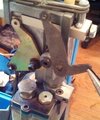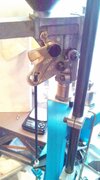@Mark_Mark - just a quick observation of this experimental method: by pulling a shooting site, a hand loading/reloading forum, you’re building observation bias into the dataset. Among the broad population of reloaders, those of us which have sufficient interest in the craft to spend our time frequenting forums to discuss the topic are much more likely to be better at the craft than most, which in most cases would also mean, we’re more likely to be more attentive and/or have processes which are better developed with sub-processes which prevent under-charging or over-charging cases. So even though this particular sub-set of reloaders is more likely to have reloaded and fired more rounds than MOST reloaders, we're also more committed to the task so we learn in more productive ways, and operate in more controlled processes than the average reloader. And by saying "average reloader," remember, the "average reloader" is someone with a VERY dusty press, and someone who has never even viewed an online reloading forum. They bought a book and a press, maybe a kit, and maybe they've reloaded a few times, maybe only once... Relatively speaking, there are far fewer folks near the top end of the spectrum of highly skilled and experienced reloaders than there are folks near the bottom end which have absolutely no idea what they are doing beyond what it says to do in the book.
Reading this thread, I have to admit, I'm a little frustrated by the reminder of the mis-focus we have as a culture of reloaders. Within this thread, we have largely discussed predominantly UNDER charge failures, creating squibs, which prompts me to remind folks, squibs are a LOW pressure event, and are only dangerous to the shooter not paying attention.
AT LEAST TWO MISTAKES MUST HAPPEN FOR A SQUIB TO RESULT IN AN OVERPRESSURE EVENT. There must first be a mistake at the reloading bench where a powder charge is missed, or grossly under charged, or an inappropriate powder/primer combination is chosen which does not fully ignite AND subsequently, the shooter must be inattentive at the range and fail to notice their squib when firing, and then send another round up the tail of the stuck bullet.
But, squib-booms do happen, because there ARE inattentive shooters in the world. They shouldn't happen, because at least two mistakes have been made, which kinda implies at least an additional mistake was made, meaning there was no QC check step in the process to confirm the presence of powder before seating bullets, so the reloader/shooter failed to charge a case, or grossly under charged, then failed to check their charge before seating or before firing, AND they failed to acknowledge a squib when firing... The reloader/shooter which makes three subsequent independent procedural mistakes doesn't draw much sympathy from me, because they had at least 3 opportunities to avoid the resulting failure... But squib-booms are probably the most common or second most common cause for catastrophic destruction of firearms.
The other most common cause for catastrophically destructive over-pressure events is mis-identification of powders at the reloading bench. When guys grab the wrong can, bad, bad things happen. For example, I know 42.5grn of Varget accidentally replacing H4350 under a 140grn ELD in 6.5 creed would create ridiculously high pressure, and it's common for a shooter to have a 223/5.56 which eats Varget as well as a 6.5 Creed which eats H4350. And a guy like me who shoots a lot of magnum revolvers as well as does some big game hunting might have an opportunity to mistakenly put 76grn of H110 into a 300win mag case instead of H1000 - and I'm not sure there would even be a body left behind after that went off... Any time a pistol powder inadvertently finds its way into a rifle case, there is opportunity for carnage. And unfortunately, the only available control for avoiding this failure mode is procedural, not mechanical - the answer is only "be careful to make sure you have the right powder." which isn't terribly productive. In professional risk management protocols for process safety design, any failure mode which has an A or B classified failure mode (SIF potential - Significant Injury or Fatality) meaning one or more people in the immediate or nearby area could be injured or killed MUST have non-procedural, mechanical safeguards and typically MUST have more than one ISL - independent safety layer. In this case, unfortunately, there really is no mechanical safety mechanism which can prevent the wrong powder from being used, only procedural safeguards - human processes - and really only ONE human process, which only counts as 1/2 ISL... so we're stuck with 1/2 ISL instead of having the 1.5 which should be required were a reloading bench under the purview of professional process health and safety managers...
Maybe acknowledging here too - there are SCARY events which damage firearms and can cause injury, which are case failures, which are predominantly caused by one of two things - less commonly caused by gunsmiths cutting excessive chamfer on the chamber mouth, meaning cases aren't supported along the base of the case wall, and more commonly, unfortunately, a LOT of new reloaders read reloading manuals and follow die instructions for how to (incorrectly) set up their sizing dies and they grossly under-size their brass, and create case stretch and eventually case failure (Lee and Lyman manuals instruct to screw the die to touch the shellholder plus 1/4-1/2 turn cam over, Hornady acknowledges contact + cam over; which in most rifle chambers creates excessive headspace and damages brass in short time). Again, these failures typically just blow out the magazine and damage the extractor, and scare the hell out of the shooter, but overall are just SCARY, not catastrophically destructive.
Unfortunately, however, most chatter we see online about reloading safety comes in the form of "never go over book max," or "don't load near max loads, it's too risky," none of which has any founding in real world failures. We know pressure proofing processes grossly exceed the maximum pressure standards for manufactured ammunition and reloading data information, and we are blessed in most cartridges that double charges or gross-overcharges simply don't fit into the case. When folks over-charge cases, the common result is a stuck action, or at worst, a blown case, which blows out the magazine and damages the extractor, but in general, the firearm is easily and inexpensively repaired. Double charges for most rifle and magnum revolver loads warn the reloader by spilling themselves all over the bench, because they simply don't fit into the case. So double charges are really only the risk to the pistol and low pressure revolver guys (and some straightwall cartridge rifle guys) who are loading very low fill ratios with fast powders, while the rest of reloaders really don't have problems. However, again, Double Charges really require TWO independent failure modes to cause an over pressure event - the reloader has to have a double charge occur, AND they have to either fail to include a QC step which checks charges before seating or checks ammo weight before firing, OR fail in those processes to catch the double charge (for example, only checking 1 in 5 cartridges instead of all cartridges, or just being lazy and not checking at all). Slight over-charges are harder to catch, but again, most firearm designs aren't so under-designed that a slight over-charge would actually cause catastrophic, destructive failure of the firearm.
So that's a frustrating paradigm to me - way too many reloaders focus their fears on "over-charges" which really are exceptionally rare, including even double charges for most reloading applications, whereas overcharges make up a NEAR-ZERO percentage of actual firearm detonations. Squibs in the hands of inattentive shooters, mistaken powder usage, and case failures due to incorrect die set up are far more common destructive "failures" which actually happen in the real world.


 Another time, I was giving a demonstration to a Boy Scout troop, and hadn't primed the cases! I noticed that when the fine-grained powder started leaking out of the primer pockets!
Another time, I was giving a demonstration to a Boy Scout troop, and hadn't primed the cases! I noticed that when the fine-grained powder started leaking out of the primer pockets!


